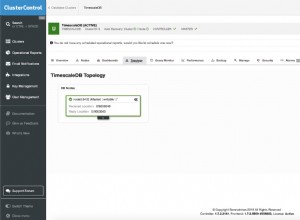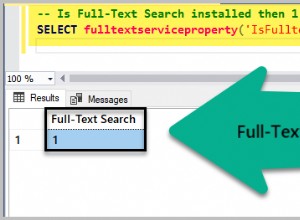कर्सर का उपयोग करने के लिए उसके चारों ओर कुछ मानक बॉयलरप्लेट कोड की आवश्यकता होती है।
तालिका से मानों के प्रत्येक सेट के लिए संग्रहीत कार्यविधि को कॉल करने के लिए कर्सर का उपयोग करने के लिए अनिवार्य रूप से समान बॉयलरप्लेट की आवश्यकता होती है। आप SELECT वे मान जिन्हें आप पास करना चाहते हैं, जहां से आप उन्हें प्राप्त कर रहे हैं (जो एक अस्थायी तालिका, आधार तालिका या दृश्य हो सकता है, और संग्रहीत कार्यों में कॉल शामिल कर सकते हैं) और फिर उन मानों के साथ प्रक्रिया को कॉल करें।
मैंने नीचे उस बॉयलरप्लेट कोड का एक वाक्यात्मक रूप से मान्य उदाहरण लिखा है, टिप्पणियों के साथ यह समझाने के लिए कि प्रत्येक घटक क्या कर रहा है। कुछ चीजें हैं जो मुझे केवल "सिर्फ इसलिए" कुछ करने के लिए कहने से ज्यादा नापसंद हैं - इसलिए सब कुछ (उम्मीद है) समझाया गया है।
आपने कई मानों के साथ प्रक्रिया को कॉल करने का उल्लेख किया है, इसलिए यह उदाहरण 2 का उपयोग करता है।
ध्यान दें कि उसके साथ होने वाली घटनाएं किसी कारण के लिए एक विशिष्ट क्रम में होती हैं। चर को पहले घोषित किया जाना चाहिए, कर्सर को उनके जारी रखने वाले हैंडलर से पहले घोषित किया जाना चाहिए, और लूप को उन सभी चीजों का पालन करना होगा। इससे यह आभास होता है कि यहाँ कुछ अत्यधिक अनम्यता है, लेकिन वास्तव में ऐसा नहीं है। आप BEGIN . के अंदर अतिरिक्त कोड नेस्ट करके ऑर्डरिंग रीसेट कर सकते हैं ... END प्रक्रिया निकाय के भीतर ब्लॉक; उदाहरण के लिए, यदि आपको लूप के अंदर दूसरे कर्सर की आवश्यकता है, तो आप इसे लूप के अंदर घोषित करेंगे, दूसरे BEGIN के अंदर ... END .
DELIMITER $$
DROP PROCEDURE IF EXISTS `my_proc` $$
CREATE PROCEDURE `my_proc`(arg1 INT) -- 1 input argument; you might not need one
BEGIN
-- from http://stackoverflow.com/questions/35858541/call-a-stored-procedure-from-the-declare-statement-when-using-cursors-in-mysql
-- declare the program variables where we'll hold the values we're sending into the procedure;
-- declare as many of them as there are input arguments to the second procedure,
-- with appropriate data types.
DECLARE val1 INT DEFAULT NULL;
DECLARE val2 INT DEFAULT NULL;
-- we need a boolean variable to tell us when the cursor is out of data
DECLARE done TINYINT DEFAULT FALSE;
-- declare a cursor to select the desired columns from the desired source table1
-- the input argument (which you might or might not need) is used in this example for row selection
DECLARE cursor1 -- cursor1 is an arbitrary label, an identifier for the cursor
CURSOR FOR
SELECT t1.c1,
t1.c2
FROM table1 t1
WHERE c3 = arg1;
-- this fancy spacing is of course not required; all of this could go on the same line.
-- a cursor that runs out of data throws an exception; we need to catch this.
-- when the NOT FOUND condition fires, "done" -- which defaults to FALSE -- will be set to true,
-- and since this is a CONTINUE handler, execution continues with the next statement.
DECLARE CONTINUE HANDLER FOR NOT FOUND SET done = TRUE;
-- open the cursor
OPEN cursor1;
my_loop: -- loops have to have an arbitrary label; it's used to leave the loop
LOOP
-- read the values from the next row that is available in the cursor
FETCH NEXT FROM cursor1 INTO val1, val2;
IF done THEN -- this will be true when we are out of rows to read, so we go to the statement after END LOOP.
LEAVE my_loop;
ELSE -- val1 and val2 will be the next values from c1 and c2 in table t1,
-- so now we call the procedure with them for this "row"
CALL the_other_procedure(val1,val2);
-- maybe do more stuff here
END IF;
END LOOP;
-- execution continues here when LEAVE my_loop is encountered;
-- you might have more things you want to do here
END $$
DELIMITER ;




